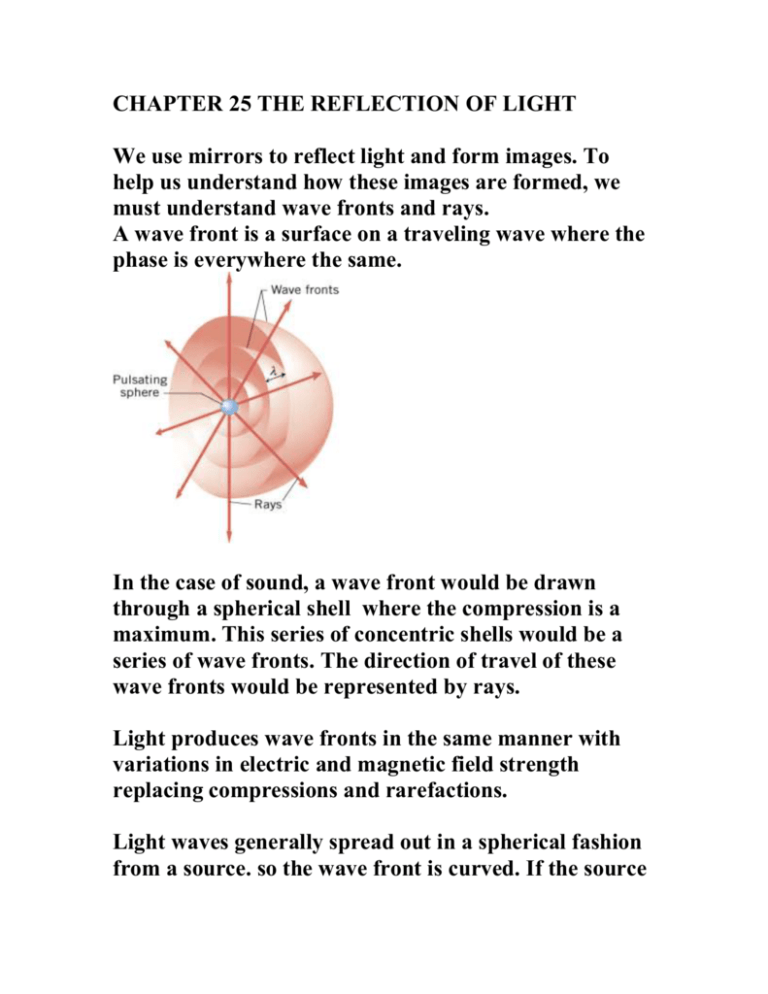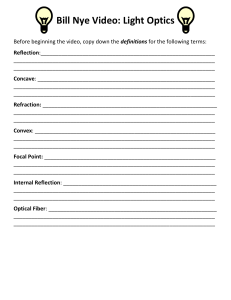Chapter 25 Notes - Valdosta State University
advertisement

CHAPTER 25 THE REFLECTION OF LIGHT We use mirrors to reflect light and form images. To help us understand how these images are formed, we must understand wave fronts and rays. A wave front is a surface on a traveling wave where the phase is everywhere the same. In the case of sound, a wave front would be drawn through a spherical shell where the compression is a maximum. This series of concentric shells would be a series of wave fronts. The direction of travel of these wave fronts would be represented by rays. Light produces wave fronts in the same manner with variations in electric and magnetic field strength replacing compressions and rarefactions. Light waves generally spread out in a spherical fashion from a source. so the wave front is curved. If the source is far enough away from the wave front being studied, the wave front can be considered to be a plane wave front. The rays are always perpendicular to the wave front. In the case of a plane wave front, the rays are parallel. When light is incident on a surface it can be absorbed, scattered, refracted, transmitted, undergo diffuse reflection or regular reflection. In this chapter we will be studying regular reflection. Any time light is reflected, it obeys the Law of Reflection which states: The incident ray, the reflected ray, and the normal to the surface all lie in the same plane and the angle of reflection equals the angle of incidence. Regular or specular reflection occurs with mirrors and other shiny surfaces. Diffuse reflection occurs with rough surfaces such as flat paint, most clothing, etc. Formation of Images by a Plane Mirror. In the lab we investigated this type of image formation, first for a point and then for a triangle. These are the characteristics of the image formed by a plane mirror. 1. The image is upright. 2. The image is the same size as the object. 3. The image distance is the same as the object distance. 4. The image is virtual. 5. The image is reversed, right to left. The formation of an image in a plane mirror is illustrated above. Notice that no light actually comes from the location of the image to the eye. That is what defines this image as virtual. This illustration shows how we know the object distance is equal to the image distance in the case of a plane mirror. Notice that the two triangles are congruent. Sometimes this branch of optics is called geometrical optics for obvious reasons. Mirrors and lenses Spherical Mirrors A spherical mirror has a curved surface that reflects light in a regular fashion. Its curvature is determined by the size of the sphere it could have been cut from. The radius of the sphere is equal to the radius of curvature of the mirror. On the left we see a concave mirror since the light strikes the inside surface of the original sphere. On the right we have a convex mirror since the light strikes the outside of the original sphere. If the center of the mirror curves toward the light source, the mirror is convex. If the center of the mirror curves away from the light source, it is concave. Of the three types of mirrors, only concave mirrors can form a real image. This real image is formed since light rays from the object actually converge at some point in front of the mirror. If we place a screen there, we will see the image of the object on the screen. We will see that it is also possible to place the object at a location relative to the mirror where a real image will not form. This type of mirror is called a converging mirror. In the case of a convex mirror, as with a plane mirror, only a virtual image can be formed. As you can see, rays from a single point will always diverge after striking the surface forming a virtual image. This type of mirror is called a diverging mirror. In both cases, the focal length F is the distance relative to the vertex of the mirror where an image is formed from incoming parallel rays. In the case of the concave mirror, it is positive> In the case of the convex mirror, it is negative. In both cases the magnitude of the focal length is equal to one half the radius of curvature. Spherical aberration is a distortion of an image formed by spherical mirrors due to the fact that parallel incoming rays farthest from the principal axis are not reflected through the focal point. This is corrected by using mirrors with a parabolic surface so that all the parallel incoming rays pass through the focal point. Formation of Images by Spherical Mirrors Ray tracing is a technique that allows us to graphically find the location of an image produced by a mirror or lens. The three rays normally used to determine image locations are illustrated above. Only two are really needed to define a point on an image. Above we see two cases illustrating the formation of a real image. Notice that the object and image are interchangeable. This diagram illustrates how a virtual image can be formed with a concave mirror. Notice that the virtual image is upright while the real image was inverted. Ray tracing can also be used to determine image location with convex mirrors. The rays used are the same, but the image is always virtual, upright and reduced in size. The Mirror Equation and the Magnification Equation The diagrams above are used to understand the magnification equation and the mirror equation. In diagram (a) the two triangles are similar since θi = θr, the angle with the principal axis in both cases is 90°, and every triangle has a total of 180°. Since they are similar, we can write: -hi/ho = di/do hi is negative since it is below the principal axis. This is the magnification equation since magnification is defined as the ratio of the image height to the ratio of the object height. It is usually written with the negative sign on the right side of the equation. The mirror equation relates the focal length, the object distance, and the image distance. It is: 1/f = 1/do + 1/di For a concave mirror, the focal length is always positive and the object distance is always positive indicating that they are in front of the mirror. The image distance is positive if the image is in front of the mirror or it is negative if the image is formed behind the mirror. Example A concave mirror(R = 56.0 cm) is used to project the image of a slide on a wall.The slide is 31.0 cm from the mirror and a light shines through the slide. (a)How far from the wall should the mirror be located to produce a clear image? (b) If the picture on the slide is 0.95 cm high, what is the height of the image? (c) How should the slide be oriented to produce an upright image on the wall? The same equations shown for concave mirrors can be used with convex mirrors if we remember that the focal length of a convex mirror is negative. Since a convex mirror is a diverging mirror, the focal point is located behind the mirror. Distances behind the mirror are considered negative. Example An object is placed 9.00 cm in front of a mirror. The image is 3.00 cm closer to the mirror when the mirror is convex instead of planar. Find the focal length of the convex mirror. P 768 Questions 3, 6, 7, 9, 10, 11, 13 P 769 Problems 2, 3, 6, 7, 9, 12, 16, 17, 19, 20, 22, 24






